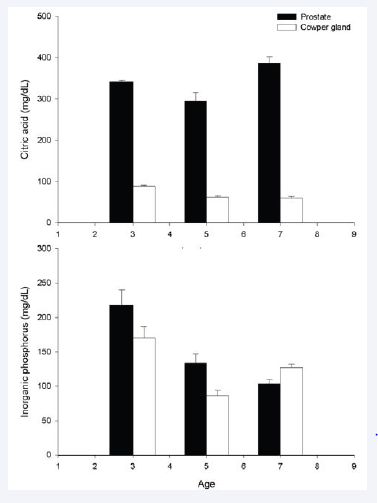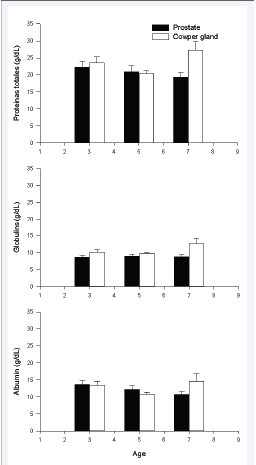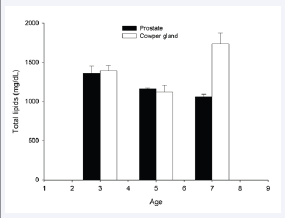Physical Characteristics and Selected Biochemical Components of Male Alpaca Accessory Sex Glands
- 1. Escuela Profesional de Medicina Veterinaria, Universidad Nacional San Antonio Abad, Perú
- 2. Facultad de Medicina Veterinaria y Zootecnia, Universidad Nacional del Altiplano, Peru
Abstract
Physical characteristic and selected biochemical components of accessory glands secretions in male alpacas of reproductive age were characterized. Prostate and Cowper’s glands were dissected from the rest of reproductive organs from 3, 5, and 7 years old males. Secretions were expressed by digital pressure and collected into vials for visual inspection, and then processed at the laboratory for concentrations of glucose, fructose, citric acid, inorganic phosphorus, total proteins, albumin, globulins and total lipids. Prostate secretion was milky, opaque, and slightly gelatinous; while Cowper’s gland secretion was bluish white, mucoid, very thick, dense and gelatinous. Concentrations of citric acid (341.4 mg/dL), inorganic phosphorus (151.9 mg/dL) in prostate secretion were significantly higher (P<0.05) than in Cowper’s gland secretion. Cowper’s glands fructose (75.3 mg/dL), globulins (10.9 g/dL), and total lipids (1417.9 mg/dL) were significantly higher (P<0.05) than in prostate gland secretion. Glucose (171.3 mg/dL), total proteins (22.3 g/dL) and albumin (12.5 g/dL) were not different between prostate and Cowper’s gland secretions. The gelatinous aspect of alpaca semen is primarily due to secretion of Cowper’s gland secretion.
Keywords
• Alpaca
• Prostate
• Cowper’s gland
• Effluent composition
CITATION
Bravo PW, Garnica J, Charaja W (2017) Physical Characteristics and Selected Biochemical Components of Male Alpaca Accessory Sex Glands. JSM Invitro Fertil 2(3): 1019.
INTRODUCTION
Male alpacas have two accessory sex glands, prostate and bulbourethral glands (Cowper’s glands), and they do not have seminal vesicles [1]. The semen of alpacas is thick, viscous and gelatinous in appearance. This peculiarity makes it difficult to make a film for further evaluation. Spermatozoa are entrapped in such thick seminal plasma giving the appearance of being dead because of their extremely slow movement. Seminal plasma is a vehicle that protects and maintains live spermatozoa in the ejaculate and its function is to hold spermatozoa until ovulation, which occurs 24 to 36 hours after copulation.
Reports on the characteristic of the secretion of accessory glands in other livestock species include bulls [2], stallions [3], and boars [4]. Their importance is substantiated by the fact that seminal plasma contributes in the metabolism of spermatozoa, provides enzymes and other components crucial for spermatozoa survival. There are only a few reports on the origin of seminal plasma components in South American camelids, Garnica et al. [5], Kershaw-Young and Maxwell [6], Kershaw-Young et al. [7], however, a detailed composition by accessory glands is still missing. Therefore, the aim of this study was to determine the physical characteristics and some biochemical components of prostate and Cowper’s glands secretions in male alpacas of reproductive age
MATERIALS AND METHODS
Twelve male alpacas, four individuals per each age group of three, five and seven years old, were used in this study. Animals were kept grazing native pastures at La Raya Research Center which is located at 4200 m above sea level. All males participated during the breeding season and were used for evaluation of secretions 30 days after the breeding season was over.
Studied individuals were chosen randomly from a herd of 150 males used for breeding. After slaughtering, genital organs were isolated and transported to the laboratory to assess physical and biochemical components. Prostate and Cowper’s glands were further dissected and excised by the medial aspect of each one. Secretions were expressed by manual pressure and collected into plastic vials until 2 ml of fluid was obtained.
Physical evaluation of the secretion was conducted by visual assessment and appearance described as milky, mucoid, thick, and/or translucid. Biochemical components were determined immediately after secretion collection. Glucose was determined by the Gochman and Schminz method [8]. Fructose was determined by spectrophotometry following the protocol of Karkoven and Malm [9]. Citric acid was determined following the protocol of Gruber and Mollering [10]. Inorganic phosphorus was determined by espectrofotometry following the method of Fiske and Subbarrow [11]. Total proteins were determined using the method of Kingsley [12]. Albumin was determined using the method of Peters et al. [13]. Globulins were determined by the difference between total proteins and albumin. Total lipids were determined by using the method of Folch et al. [14].
Data were analyzed using a factorial 2 x 3 design wherein the main factors were secretions of the prostate and Cowper’s glands, with three age groups, three, five and seven years old. Test for differences, Tukey test was used.
RESULTS
Physical characteristics
Color: Prostate effluent was milky, creamy and opaque in all age group samples. Cowper’s glands fluid was white bluish (Table 1). Aspect: Prostate fluid was like condensed milk. Cowper glands fluid aspect was similar to a mucoid secretion.
Consistency:
Prostate fluid was slightly gelatinous. Cowper’s gland fluid was highly gelatinous and dense. In all physical aspects of accessory glands secretions there was no difference (P >0.05) attributed to age group considered in this study.
Figure 1 Concentrations of glucose and fructose secreted by the prostate and Cowper’s glands of 3, 5, and 7 years old alpacas. Concentrations of glucose and fructose secreted by the prostate and Cowper’s glands of 3, 5, and 7 years old alpacas.
Biochemical components
The overall means and standard errors of the mean of all biochemical components determined in this study are shown in Table 2. Glucose concentrations were different than fructose in prostate and Cowper’s gland secretion, and at the study groups considered in this report (Figure 1).
Citric acid secretion was evenly distributed in the three study groups; however it was different (P0.05) in the three group ages (mean 140 mg/dL), as well as between the two accessory sex glands of alpacas, prostate (152 mg/dL) and Cowper’s glands (128 mg/dL).
Figure 2 Concentrations of citric acid and inorganic phosphorus from the prostate and Cowper’s glands of 3, 5, and 7 years old alpacas.
Total proteins concentrations were also not different (P>0.05) between the three study groups (mean, 22.3 g/dL), neither different between prostate (20.8 g/dL) and Cowper’s glands (23.7 g/dL). There was more (P<0.05) albumin (12.5 g/ dL) than globulins (9.8 g/dL) considering the study groups. The same trend was observed between the prostate and Cowper’s glands (Figure 3).
Figure 3 Concentrations of total proteins, globulins and albumin from the prostate and Cowper’s glands of 3, 5, and 7 years old alpacas.
Total lipids concentration were not different (P>0.05) between the three study groups (mean, 1306 mg/dL); however, Cowper’s glands possessed more (P<0.05) total lipids (mean, 1418 mg/dL) than prostate (mean, 1194 mg/dL) (Figure 4).
Figure 4 Concentrations of total lipids from the prostate and Cowper’s glands of 3, 5, and 7 years old alpacas.
DISCUSSION
The physical aspects of alpaca accessory glands secretions have been described in this study and they are different from humans and dogs, wherein they are colorless [15]. In the stallion prostatic secretions are watery and thin [16], by contrast in the alpaca prostate secretions are whitish comparable to a condensed milk which is markedly different and in alpacas is milky and dense. In addition, alpaca secretion from the Cowper’s glands is mucoid and gelatinous. Thus, the component that gives most of the gel appearance to the ejaculated alpaca semen is given by the secretion of Cowper’s gland. In this regard, in most species the substrate for gel formation consists of a protein like material and secreted by the seminal vesicles [15].In the case of the alpaca, since they do not have seminal vesicles, it is unknown the source of this substrate but evidence from this paper points out to the Cowper’s glands; however, the presence of vesiculase in the alpaca (enzyme to digest the gel) remains to be elucidated.
Glycosaminoglycans (GAGs) formerly known as mucopolysacharides, are highly negatively charged protein molecules, with extended conformation that imparts high viscosity to the solution. Sulphated mucopolysacharides have been demonstrated in the Cowper’s glands from camels [17], indicating that alpacas may also secrete this type of substances, and most of them would come from the Cowper’s glands. In addition, the Cowper’s glands secrete a gel forming matrix in the boar [18], and that could also the case in the alpaca.
The influence of age on the biochemical components of prostate and Cowper’s glands appears to be nonexistent with the exception of fructose. Fructose is less concentrated in older male alpacas, i.e., 7 years-old. In fact, fructose was higher in younger males, 3 years-old than in 5 and 7 years-old. This tendency appears to be peculiar in alpacas, as no reference as far as age was found in the literature.
Prostatic secretion from humans and dogs are colorless [15], also is the main source of citric acid, and comparable to alpaca prostate, but not reducing sugar. In addition, prostate secretions contain less protein than the Cowper’s glands which is similar to humans [15]. Alpaca prostate and Cowper’s gland have plenty of inorganic phosphorus with no difference between accessory glands, and represent ten times the concentration found in humans [15].
The peculiarities of accessory glands secretion in alpacas is as follows: The prostate secretes more citric acid, five times more than the Cowper’s gland, as reported in humans [15]. By contrast, the Cowper’s gland secretes more fructose than the prostate. The other components determined in this study, namely glucose, inorganic phosphorus, and proteins are equally secreted by accessory glands, prostate and Cowper’s glands. It is of interest that in alpacas more glucose is secreted than fructose. This means that during the process of respiration of the spermatozoa glucose has to be converted into fructose as demonstrated by Mann [19]. It is unknown if in alpacas, the process of conversion of glucose into fructose is via glucose phosphate and/or sorbitol. It is also noteworthy to mention that alpaca spermatozoa show more affinity for glucose than fructose as reported earlier [20]. Similar observations have been also made in camels [21]. Fructose, rather than glucose is the principal reducing sugar in seminal plasma. Fructose concentrations are particularly high in bull and ram seminal plasma, but considerably lower in other species, whereas fructose is essentially absent from dog and stallion semen [22]. Our results varied from camels where in higher concentrations of fructose (360 to 621 mg/dL) than of glucose (3.1 to 6.5 mg/dL) in seminal plasma of camels during the root season. Altogether there was less fructose than glucose, which could a factor in the composition of extenders for alpacas. In the same way, citric acid concentrations were far less in camels (23.4 to 41 mg/dL; [23].
Alpacas do not have seminal vesicles and as such the secretion of these glands is replaced by the prostate and/or Cowper’s glands. In this regard, the prostate secretes more citric acid than the Cowper’s glands. Similar situation happens in humans wherein the prostate secretes large amounts of citric acid [19]. By contrast, in the boar the seminal vesicles secrete more citric acid and fructose than the prostate. This is not the case in alpacas, the prostate takes over the secretion of citric acid and fructose is secreted equally by the prostate and Cowper’s glands. In general, alpaca accessory glands secrete less citric acid than bulls [24].
Proteins represented the highest constituent compared to the rest of the biochemical components determined in this study. In fact, they represent 19 times higher than lipids and they may part as one the main constituents of the gel type secretion of the whole ejaculate. Similar results have been reported in stallions [25], and reported lately in alpacas [6,7]. The case of total lipids is of interest. In alpacas, Cowper’s glands secrete more total lipids than the prostate, and this is well reflected in the physical appearance of secretion of each sex gland. However [26], this is not the case in humans, wherein the prostate secretes more lipids than the bulbourethral glands [15].
In conclusion, the gelatinous aspect of the seminal plasma of the alpaca is given by the secretion of the Cowper’s glands, and might be associated to the protein concentrations. Glucose appears to be the main sugar rather than fructose in alpaca seminal plasma.
Table 1: Physical characteristics of Prostate and Cowper’s gland secretion in alpacas.
| Characteristic | N | Prostate | Cowper’s glands |
| Color | 12 | Milky | Bluish white |
| Aspect | 12 | Creamy, opaque | Mucoid |
| Consistency | 12 | Slightly gelatinous | Dense, highly gelatinous |
Table 2: Means ± SEM (standard error of the mean) of some biochemical components of accessory sexual glands in alpacas by age.
| Biochemical Component |
Age in years | ||
| Three years | Five years | Seven years | |
| Glucose (mg/dL) | 185.3 ± 7.7 | 157.3 ± 21.5 | 171.4 ± 18.7 |
| Fructose (mg/dL) | 66.5 ± 17.5c | 58.2 ± 17.6b | 46.2 ± 29.3a |
| Citric acid (mg/dL) | 205.4 ± 149.2 | 178.8 ± 127.2 | 223.9 ± 175.8 |
| Inorganic Phosphorus (mg/dL) | 194.6 ± 43.3 | 110.1 ± 32.4 | 115.3 ± 16.8 |
| Total proteins (g/dL) | 22.9 ± 1.9 | 20.6 ± 1.5 | 23.4 ± 1.6 |
| Albumin (g/dL) | 13.5 ± 0.8 | 11.4 ± 0.8 | 12.7 ± 0.7 |
| Globulins (g/dL) | 9.4 ± 0.6 | 9.3 ± 0.5 | 10.7 ± 0.6 |
| Total Lipids (mg/dL) | 1378.8 ± 57.9 | 1141.7 ± 56.6 | 1397.8 ± 55.7 |
Table 3: Biochemical components of prostate and Cowper's gland secretions in male alpaca, (mean ± SEM). Stars indicate significant difference between accessory glands.
| Biochemical component | Prostate | Cowper gland | General |
| Glucose (mg/dL) | 169.7 ± 4.9 | 172.9 ± 4.9 | 171.3 |
| Fructose (mg/ dL) | 38.6 ± 15.3* | 75.3 ± 10.9* | 56.9 |
| Citric acid (mg/ dL) | 341.4 ± 53.2* | 63.9 ± 6.3* | 202.7 |
| Inorganic Phosphorus (mg/dL) | 151.9 ± 57.5* | 128.1 ± 41.0* | 140.0 |
| Total proteins (g/dL) | 20.8 ± 1.0* | 23.7 ± 1.1* | 22.3 |
| Albumin (g/dL) | 12.2 ± 0.6 | 12.9 ± 0.6 | 12.6 |
| Globulins (g/dL) | 8.7 ± 0.4* | 10.9 ±0.6* | 9.7 |
| Total Lipids (mg/ dL) | 1194.4 ± 47.3* | 1417.7 ± 47.6* | 1306.1 |












































































































































